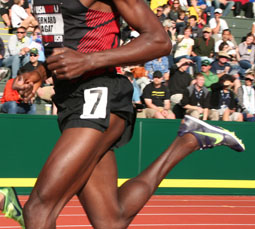☰ Chapter 9: Angular Kinetics
Objectives:
- Define moment of inertia
- Explain:
- How the human body's moment of inertia may be manipulated
- Newton's laws of motion as they apply to angular motion
- Define angular impulse and angular momentum
- Explain the relationship between angular impulse and angular momentum
Linear and Angular Quantities
Newton's First Law of Motion (relating to angular motion)
Angular Inertia (Moment of inertia): The property of an object to resist changes in angular motion
Angular inertia depends upon mass and mass distribution
Angular inertia
\(I_b = mk^2 + mr^2 \)
\(I = mk^2 \)
Angular inertia in a runners leg
What is the benefit to having limbs that are tapered (The proximal ends are larger than the distal ends)?

Moment of inertia in a bicycle wheel
cycling
|
What would be desriable in terms of bicycle wheel design (focus on inertia of the wheel I=mk2)?

By Ullermann - Own work, CC BY-SA 3.0, Link
|
Ice-skating examples of manipulating inertia (Calculation)
Diving examples of manipulating inertia
Angular Momentum: \(H = {I ω}\)
Angular momentum in a non-rigid body can be estimated by:
\(H = Σ({I ω})\)
Angular momentum is conserved when no external torques are created on the body.
Angular momentum conservation requires H to be constant.
However, I and ω can change.
Thought Questions
1. Angular momentum is conserved in which of the following activities:
- Gymnastics vault while in the air
- Giant swing in gymnastics
|
|
- Spin about the longitudinal axis in ice-skating
2. How does "choking up" on a baseball bat affect performance?
3. Does a golf club have greater angular inertia when it is held vertically or horizontally?
Newton's Second Law of Motion (relating to angular motion)
| Linear |
Angular |
| \(F=ma\) |
\(T=Iα\) |
F=ma led to \(FΔt = mΔv\)
In angular motion, \(T=Iα\) leads to \(TΔt = Δ(Iω)\)
A change in angular momentum may result in:
- A change in angular velocity (volleyball serve with topspin)
- A change in direction of the axis of rotation (bicycle wheel gyroscope)
- Diving with a twist
- A change in moment of inertia
True, false, or "it depends": Angular acceleration of an object indicates the presence of a net external torque.
Newton's Third Law of Motion (relating to angular motion)
For every torque exerted by one object on another, the other object exerts an equal torque back on the first body but in the opposite direction
Long jumping (video)
Frolich article

